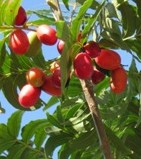 Kafir plum is an evergreen tree native to Eastern parts of Southern Africa from the Cape through Mozambique and Zimbabwe where it is found on forest river banks. It is a member of the mango family (Anacardiaceae) along with cashew and pistachio nut trees. The main stem is straight and in the forest often has supporting buttress roots that extend over thirty feet on the forest floor. The bark is smooth at first but becomes rough and dark gray-brown as it matures. The numerous spreading branches are curved upwards and carry pinnately compound leaves with sickle shaped leaflets 2.5 inches long in terminal whorls. The leaves are red when they first emerge but turn dark glossy green as they mature. Small whitish-green male and female flowers are produced in large panicles on separate trees in summer. Female flowers give way to one seeded fleshy edible fruits .5 to 1.5 inches across that ripen to red and are attractive to wildlife. Kafir plum is valued as a shade tree for both the garden and street, and as a means of attracting birds and butterflies to the garden. The fruits are used to make jams, jellies and rose wine. The wood is not durable but is useful for carved trinkets and the bark has been used for many years as a medicinal herb and for dying.
Kafir plum is an evergreen tree native to Eastern parts of Southern Africa from the Cape through Mozambique and Zimbabwe where it is found on forest river banks. It is a member of the mango family (Anacardiaceae) along with cashew and pistachio nut trees. The main stem is straight and in the forest often has supporting buttress roots that extend over thirty feet on the forest floor. The bark is smooth at first but becomes rough and dark gray-brown as it matures. The numerous spreading branches are curved upwards and carry pinnately compound leaves with sickle shaped leaflets 2.5 inches long in terminal whorls. The leaves are red when they first emerge but turn dark glossy green as they mature. Small whitish-green male and female flowers are produced in large panicles on separate trees in summer. Female flowers give way to one seeded fleshy edible fruits .5 to 1.5 inches across that ripen to red and are attractive to wildlife. Kafir plum is valued as a shade tree for both the garden and street, and as a means of attracting birds and butterflies to the garden. The fruits are used to make jams, jellies and rose wine. The wood is not durable but is useful for carved trinkets and the bark has been used for many years as a medicinal herb and for dying.
Type: Deciduous tree
Outstanding Features: Shade; quick growth
Form: Rounded canopy
Growth Rate: Rapid
Bloom: Small greenish white male and female flowers on separate trees in summer
Size: 30’ H x 20’ W
Light: Full sun to partial shade
Soil: Average, medium moist, well-drained
Hardiness: Zones 10-11
Care: Fertilize annually in spring with balanced fertilizer. Prune in spring to produce picturesque shape if desired.
Pests and Diseases: Relatively pest and disease free
Propagation: Seed
Comments: Because of its rapid growth Kafir plum is useful for providing a quick effect in a new garden.